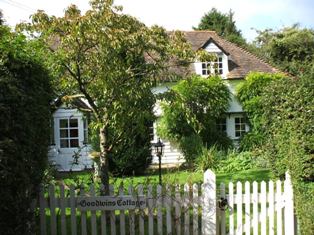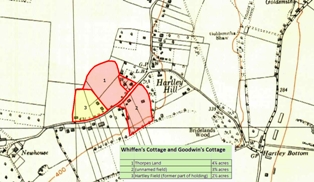Goodwins Cottage, Church Road, Hartley, Kent
These two cottages, which lie on the western side of the top end of Church Road, are both named after their 19th century occupants. Although to confuse matters for 20 years after the war the Goodwins lived at Whiffins Cottage! Whiffins Cottage was renamed "Orchard House" some years ago. As well as the two cottages, there was a small 8 acre estate, which comprised the fields to the west and north of Orchard House and a field opposite, which lies on the sites of Bonsalls, Blue Firs and San Michele (part), Church Road.
Goodwins Cottage is dated by English Heritage to the 17th century or earlier, with one storey and 3 dormer windows in the attic. Originally thatched, it now has a tiled roof. The original Whiffins Cottage is no longer with us (see below), but those who can remember think it was similar in construction, but hidden from the road by a large tree. Our only description is from Bancks who says: "Some of the beams in this cottage, as in several other houses in the parish, are old ship's timbers, curved, and showing the wooden bolts or tree nails with which they were originally fastened together."
It is probable that once these were part of a 45 acre farm at the southern end of Hartley owned by Simon Blodiner (Blundum) in 1232. In 1288 John Eylnoth, the nephew of Walter Blodiner sued unsuccessfully for recovery of a number of holdings that the estate had been split into, the court deciding that Walter had sold the land to the defendants. It is probable that the owner then was Simon atte Wode. No buildings are mentioned in 1288.
The earliest definite reference to the holding comes from the will of George Pase in 1608. He left the house and land to his wife Elizabeth and after her death to his brother William and his son William. We can be sure that George owned Whiffins Cottage because William Pase is named as the owner of land adjoining in a conveyance of Dawsland in 1633. Being a smallholding it perhaps not surprising that George Pase did not make his living solely by farming, as he describes himself as a tailor in his will.
The holding shrank after George's death, for he instructed Elizabeth to sell a 2½ acre field called the Uppermost Croft to pay his debts and legacies. The buyer was their neighbour Katherine Ellis of Hartley Hill Cottage, who probably bought it some time after 1615. Henceforth this was a holding in its own right, coming to be known as Hartley Field.
After 1633 there is a gap in our knowledge until a deed in 1669. In that year there seems to have been a family settlement between various members of the Wouldham and Whiffin families, including George and Elizabeth Whiffin. Elizabeth was a Wouldham widow, who married George at Ash Church in 1646. Both families are much more associated with Ash than Hartley. By then there were 2 houses here, the land then consisted of 2 orchards, 5 acres of arable land and 4 acres of pasture.
But it is to Hartley's neighbour to the North that we must look for the next owner of the two houses. For in 1706 they were purchased from John and Sarah Whiffin by Robert Batt of Longfield (d 1734). He later took a lease of Hartley Manor Farm in 1726. Later they were bought by Francis Glover, and then by Edward Thorpe. Edward had married Sarah Clements (d 1747) at Ash in 1721. Sarah is buried under the altar in All Saints' Church, Hartley. It appears that Edward remarried an Ann Crowhurst of Stone in 1751. He was a fairly substantial farmer, being also the tenant of Blue House Farm (Mintmakers) and Goldsmiths. He died childless in 1779, and the estate passed to his nephews Henry and Richard Thorpe. The entry in the parish register of Henry's baptism in 1743 states: "Henry son of Hannah Bail, singlewoman, afterwards married to William Thorpe ye supposed father". It is unlikely that the nephews lived in Hartley. Eventually the cottages were inherited by Henry's son, Richard.
In 1804 Goodwins Cottage was purchased by Thomas Goodwin, a rare example of a freehold cottage owner at this time when most were owned by bigger landlords. The Goodwins did not part with the cottage named after them until 1951. Generations of father and son of this family lived here and all were thatchers - up to the Thomas Goodwin listed in Kellys Directory in 1918. Goodwins Cottage was subdivided into two in about 1860 so two generations of the family could live there, although by 1910 the two halves had been reunited. Its value then was just £162! The last Goodwins to live here were Barbara and Thomas, who left in 1951.
Meanwhile the history of Whiffins Cottage took a different path. The Thorp family sold it in 1845 to the Bensteds of Hartley Court. Its inhabitants were a series of farm labourers - the Woodins, Outrams, Outreds, and, from about 1890 Thomas Whiffin and his family. His son Thomas drove a carrier's cart to Gravesend, an important early form of public transport. We know that in 1910 the family were paying a weekly rent of 3s 6d to live there. Not long after Whiffins Cottage was purchased by John C W Kershaw.
John Kershaw was born in 1871 to Rev E W Kershaw of Nottinghamshire. Both he and his younger brother Sidney had a lifetime interest in lepidoptera (butterflies and moths). He spent much time out in the far east. In 1910 he and Frederick Muir successfully introduced a fly parasite to control the sugar cane boring beetle in Hawaii. It was while they were looking for this parasite that they made an internationally important discovery of the Peripatus anthropod in the Moluccas (Indonesia), which is considered to be the missing link in the evolution from segmented worms to anthropods. He later spent 1913 in Trinidad on a froghopper pest ravaging sugar cane there. At Hartley he is remembered for being reclusive and somewhat eccentric. However his skill as a craftsman is well remembered, and he kept a furnace at the end of his garden. (Much of this biographical information comes from Professor Easton of USA, who is compiling a biography of Mr Kershaw, and would be grateful for any information).
Whiffins Cottage was destroyed on 15 September 1940 when a Hurricane crash landed into the cottage and destroyed it. September 15th came to known as Battle of Britain day, as it saw intense fighting in the air. Among them was Pilot Officer John Vinter Gurteen of 504 Hurricane Squadron based at Hendon. His squadron was scrambled at 11.20am and just after 12pm it and other squadrons encountered a formation of Dornier bombers on the edge of London. One of his collagues had a faulty gun but still managed to down a Dornier by slicing through its tail, leading it to crash by Victoria Station, a scene recreated in the 1969 film Battle of Britain. At 12.58pm P/O Gurteen was shot down and the plane dived at full throttle into the house. There was concern that Mr Kershaw might have been in the building, but fortunately he was found in the Goodwin's bomb shelter. Mr Kershaw had Whiffins Cottage rebuilt in the same style after the war, but subsequent changes have altered its appearance.
Map showing extent of Whiffins Cottage and Goodwins Cottage holding, Church Road, Hartley, Kent


